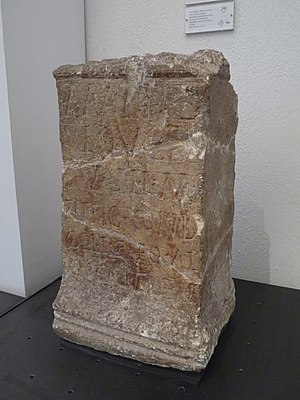Loucetios

In Gallo-Roman religion, Loucetios (Latinized as Leucetius) was a Gallic god known from the Rhine-Moselle region, where he was identified with the Roman Mars.[1] Scholars have interpreted his name to mean ‘lightning’.[2] Mars Loucetius was worshipped alongside the goddess Nemetona.[3]
Name and etymology
The name Loucetios derives from a Celtic stem *lowk-et-, meaning 'flash of lightning, thunderbolt' (cf. Old Irich lóchet), itself from the root *lowk- ('bright, light'; cf. Middle Irish luach 'glowing light', Middle Welsh llug 'eyesight, perception'). It is the source of the place name Luzech, attested as Luzechium in 1326 CE.[4]
The name may be a reference to either a Celtic common
Inscriptions and shrines
About a dozen inscriptions in honour of Mars Loucetius have been recovered, mainly from eastern Gaul, with a particular concentration among the Vangiones and Aresaces (two Rhenish tribes). Inscriptions to him have also been found at Bath and Angers;[1] the altar at Bath specifies that it was dedicated by a citizen of the Treveri.[7]
Inscriptions often invoke Mars Loucetius together with
Four of the inscriptions to Mars Loucetius are also dedicated IN H(onorem) D(omūs) D(ivinae),[9] ‘in honour of the divine house’ (i.e. the imperial family).
Wightman further suggests that the shrine of Mars Loucetius at Klein-Winternheim, south of Mainz, was “a central one for the Aresaces”,[3] the ancient inhabitants of the Mainz-Bingen area.
Modern literature
In Neil Gaiman's American Gods, Leucotios [sic] appears in chapter three, during Shadow's (the main character) dream of forgotten gods. Gaiman's Leucotios is described as a “man with ... white hair, with a necklace of teeth about his neck, holding a drum”.[10]
References
- ^ a b Nicole Jufer & Thierry Luginbühl (2001). Les dieux gaulois : répertoire des noms de divinités celtiques connus par l'épigraphie, les textes antiques et la toponymie. Paris: Editions Errance. pp. 48–49. The sites listed for Loucetius/Leucetius are Strasbourg, Worms, Eisenberg, Groß-Gerau, Klein-Winternheim, Frauenstein, Großkrotzenburg, Marienborn, Angers, and Bath.
- ISBN 9782877722377.
- ^ a b c d Edith Mary Wightman (1970). Roman Trier and the Treveri. London, England: Rupert Hart Davis. p. 219.
- ^ Delamarre 2003, p. 200.
- ^ Helmut Birkhan (2006). "Loucetius". In John Koch (ed.). Celtic Culture: A Historical Encyclopedia. ABC-Clio. p. 1192.
- ^ J.P. Mallory and D.Q. Adams (1997). "Loucetios". Encyclopedia of Indo-European Culture. Taylor & Francis. p. 513.
- ^ RIB 1, 140.
- AE2007, 1044.
- AE 1991, 1272), Großkrotzenburg (CILXIII: 7412), Worms (CIL XIII: 6221), and Eisenberg (AE 2007, 1044).
- ^ Neil Gaiman (2001). American Gods. New York, NY: HarperTorch. p. 58.
Bibliography
- ISBN 9782877723695.


